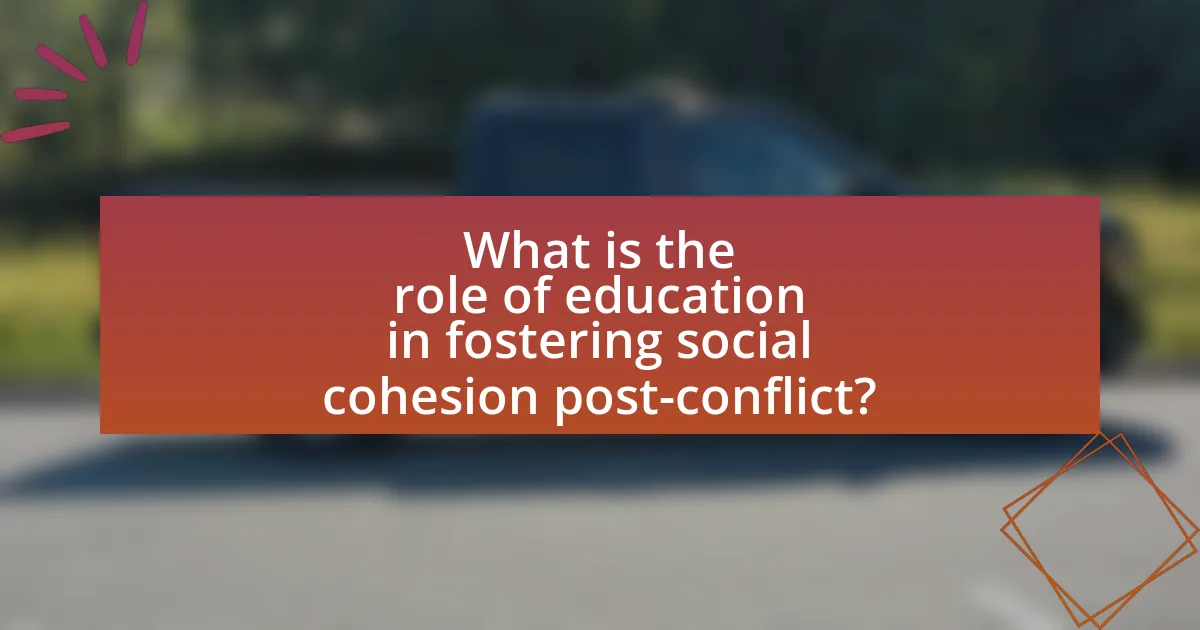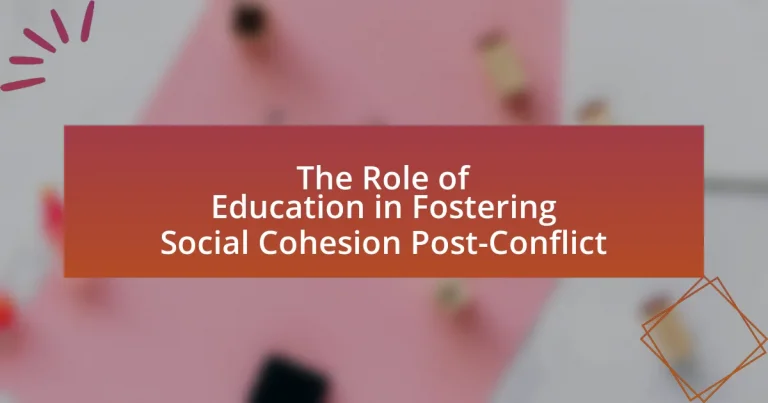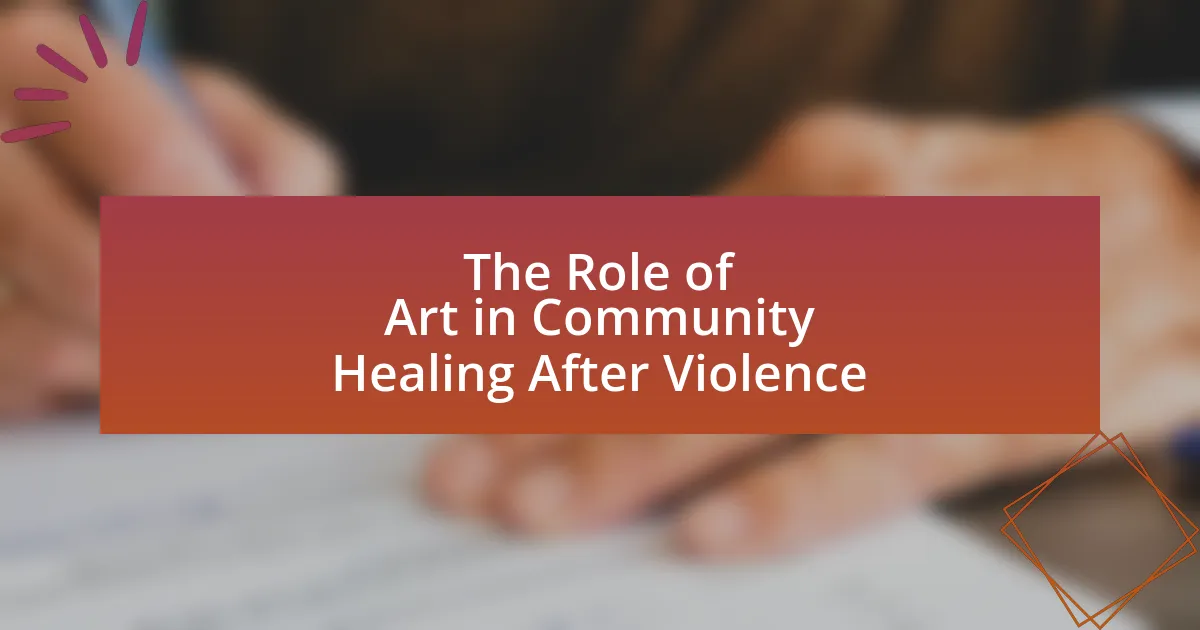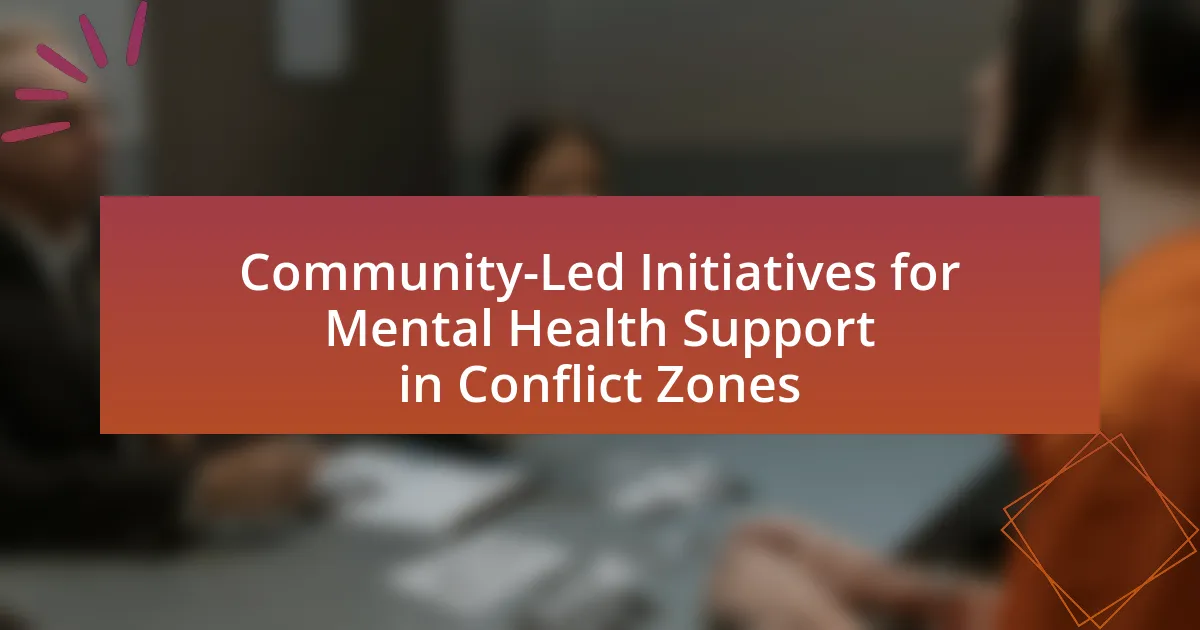The article examines the critical role of education in fostering social cohesion in post-conflict societies. It highlights how education promotes understanding, tolerance, and reconciliation among diverse groups, serving as a platform for dialogue and community rebuilding. Key strategies discussed include inclusive education, community-based learning, and psychosocial support, which are essential for mitigating social divisions and enhancing collective identity. The article also addresses the challenges faced in post-conflict educational environments, such as resource limitations and cultural differences, while emphasizing the importance of community involvement and effective monitoring to ensure sustainable educational outcomes that contribute to long-term peace and stability.

What is the role of education in fostering social cohesion post-conflict?
Education plays a crucial role in fostering social cohesion post-conflict by promoting understanding, tolerance, and reconciliation among diverse groups. It serves as a platform for dialogue, allowing individuals from different backgrounds to engage with one another, thereby reducing prejudices and fostering a sense of community. For instance, educational programs that include peace education and conflict resolution skills have been shown to significantly improve intergroup relations in post-conflict societies, as evidenced by initiatives in countries like Rwanda and Bosnia, where education has been pivotal in rebuilding trust and social networks. Furthermore, inclusive education policies that address the needs of all groups can help mitigate social divisions and encourage collective identity, reinforcing the importance of unity in the aftermath of conflict.
How does education contribute to rebuilding communities after conflict?
Education contributes to rebuilding communities after conflict by fostering social cohesion, promoting economic recovery, and facilitating reconciliation. It provides individuals with the skills and knowledge necessary to participate in the reconstruction of their societies, thereby enhancing community resilience. For instance, educational programs that include conflict resolution and peacebuilding curricula can help mitigate tensions and promote understanding among diverse groups. Research indicates that in post-conflict settings, access to education can reduce the likelihood of renewed violence; a study by the World Bank found that each additional year of schooling can decrease the risk of conflict by 10%. Furthermore, education serves as a platform for dialogue and collaboration, enabling communities to address grievances and build trust, which is essential for long-term stability.
What are the key educational strategies used in post-conflict settings?
Key educational strategies used in post-conflict settings include inclusive education, community-based learning, and psychosocial support. Inclusive education aims to integrate all children, regardless of their backgrounds, fostering a sense of belonging and reducing divisions. Community-based learning engages local populations in the educational process, ensuring that curricula reflect the community’s needs and values, which helps rebuild trust and social cohesion. Psychosocial support addresses the emotional and psychological needs of students affected by conflict, facilitating healing and resilience. These strategies are essential for rebuilding societies and promoting peace, as evidenced by programs implemented in countries like Rwanda and Bosnia, which have shown improvements in social integration and community rebuilding efforts.
How does education promote understanding among diverse groups?
Education promotes understanding among diverse groups by providing a structured environment for dialogue and interaction. Through curricula that include multicultural perspectives, students learn about different cultures, histories, and values, which fosters empathy and reduces stereotypes. Research indicates that educational programs emphasizing diversity can lead to improved intergroup relations; for instance, a study by the American Psychological Association found that students exposed to diversity training showed increased acceptance of peers from different backgrounds. This educational approach not only enhances individual awareness but also cultivates a sense of community, essential for social cohesion in post-conflict settings.
Why is social cohesion important in post-conflict societies?
Social cohesion is crucial in post-conflict societies because it fosters trust, cooperation, and a sense of belonging among individuals, which are essential for rebuilding communities. In the aftermath of conflict, social cohesion helps mitigate tensions and prevents the resurgence of violence by promoting dialogue and understanding among diverse groups. Research indicates that societies with high levels of social cohesion experience lower rates of crime and violence, as seen in the post-apartheid era in South Africa, where initiatives aimed at fostering unity significantly contributed to stability. Thus, social cohesion serves as a foundation for sustainable peace and development in post-conflict environments.
What are the consequences of a lack of social cohesion?
A lack of social cohesion leads to increased social fragmentation and conflict within communities. This fragmentation can result in heightened tensions among different social groups, leading to violence and instability, as evidenced by studies showing that societies with low social cohesion experience higher rates of crime and civil unrest. Additionally, the absence of social cohesion can hinder economic development, as trust and collaboration among community members are essential for fostering economic activities and attracting investments. Research indicates that communities with strong social ties are more resilient and better equipped to recover from crises, highlighting the detrimental effects of social disintegration on overall societal well-being.
How does social cohesion impact long-term peace and stability?
Social cohesion significantly enhances long-term peace and stability by fostering trust and cooperation among diverse groups within a society. When individuals feel connected and share common values, they are more likely to engage in constructive dialogue and resolve conflicts peacefully. Research indicates that societies with high levels of social cohesion experience lower rates of violence and civil unrest. For instance, a study by the World Bank found that social cohesion can reduce the likelihood of conflict recurrence in post-conflict settings, as communities that work together are better equipped to address grievances and build inclusive governance structures. This interconnectedness ultimately contributes to a stable environment where peace can be sustained over time.
What challenges does education face in post-conflict environments?
Education in post-conflict environments faces significant challenges, including infrastructure damage, lack of resources, and psychological trauma among students and educators. Infrastructure damage often results in the destruction of schools, making access to education difficult; for instance, UNESCO reported that in countries like Syria, over 6,000 schools were damaged or destroyed due to conflict. The lack of resources, such as textbooks and trained teachers, further hampers educational efforts, as seen in South Sudan, where only 40% of teachers are qualified. Additionally, psychological trauma affects both students and educators, leading to difficulties in learning and teaching, as highlighted by the World Bank, which notes that children in conflict zones are at a higher risk of mental health issues. These challenges collectively hinder the restoration and effectiveness of education systems in post-conflict settings.
How do resource limitations affect educational initiatives?
Resource limitations significantly hinder educational initiatives by restricting access to essential materials, qualified teachers, and infrastructure. For instance, in post-conflict settings, schools often lack basic supplies such as textbooks and technology, which impedes effective learning. According to a report by the Global Partnership for Education, over 260 million children worldwide are out of school, primarily due to inadequate resources, which directly affects their educational outcomes and social integration. Furthermore, insufficient funding leads to overcrowded classrooms and a lack of trained educators, diminishing the quality of education and limiting opportunities for students to develop critical social skills necessary for fostering cohesion in post-conflict societies.
What role do cultural differences play in educational effectiveness?
Cultural differences significantly influence educational effectiveness by shaping students’ learning styles, communication preferences, and engagement levels. For instance, research indicates that culturally responsive teaching, which acknowledges and incorporates students’ cultural backgrounds, enhances academic performance and fosters a sense of belonging. A study by Gay (2010) highlights that when educators adapt their teaching methods to reflect the diverse cultural contexts of their students, it leads to improved educational outcomes. Furthermore, understanding cultural differences can help mitigate conflicts and promote social cohesion in post-conflict settings, as education becomes a platform for dialogue and mutual respect among diverse groups.
How can education be effectively implemented to foster social cohesion?
Education can be effectively implemented to foster social cohesion by integrating inclusive curricula that promote understanding and respect among diverse cultural groups. This approach encourages dialogue and collaboration among students from different backgrounds, which is essential in post-conflict settings. Research by the United Nations Educational, Scientific and Cultural Organization (UNESCO) indicates that education systems that emphasize social-emotional learning and conflict resolution skills significantly reduce prejudice and enhance community ties. Furthermore, programs that involve community participation in educational planning and delivery have been shown to strengthen social bonds and promote a sense of belonging, thereby reinforcing social cohesion in divided societies.
What are the best practices for integrating education into peacebuilding efforts?
The best practices for integrating education into peacebuilding efforts include promoting inclusive curricula, fostering dialogue among diverse groups, and ensuring access to quality education for all. Inclusive curricula that reflect the histories and cultures of various communities can help build mutual understanding and respect. Fostering dialogue through educational programs encourages collaboration and conflict resolution skills among students from different backgrounds. Ensuring access to quality education, particularly for marginalized groups, is essential for creating equitable opportunities and reducing tensions. Research by the United Nations Educational, Scientific and Cultural Organization (UNESCO) highlights that education can significantly contribute to social cohesion and peace by addressing the root causes of conflict and promoting shared values.
How can community involvement enhance educational programs?
Community involvement can enhance educational programs by providing resources, support, and real-world relevance to the curriculum. When local organizations, businesses, and families engage with schools, they contribute expertise, funding, and volunteer efforts that enrich the educational experience. For instance, a study by the National Education Association found that schools with strong community partnerships report higher student achievement and improved attendance rates. This collaboration fosters a sense of belonging and accountability, which is crucial in post-conflict settings where rebuilding trust and social cohesion is essential. By integrating community perspectives and resources, educational programs become more responsive to the needs of students and the community, ultimately leading to a more effective learning environment.
What role do teachers play in promoting social cohesion?
Teachers play a crucial role in promoting social cohesion by fostering inclusive environments that encourage respect and understanding among diverse student populations. They facilitate dialogue and collaboration, helping students from different backgrounds to engage with one another, which is essential in post-conflict settings. Research indicates that teachers who implement cooperative learning strategies and culturally responsive pedagogy can significantly enhance social integration and reduce prejudice among students. For instance, a study by the United Nations Educational, Scientific and Cultural Organization (UNESCO) highlights that teachers trained in conflict-sensitive education can effectively mediate tensions and promote peacebuilding within the classroom.
What specific educational programs have proven successful in post-conflict settings?
Specific educational programs that have proven successful in post-conflict settings include accelerated learning programs, peace education initiatives, and vocational training schemes. Accelerated learning programs, such as those implemented by UNICEF in countries like Afghanistan and South Sudan, have effectively helped out-of-school children catch up on missed education due to conflict. Peace education initiatives, exemplified by the “Learning to Live Together” program in various African nations, promote social cohesion and conflict resolution skills among youth. Vocational training schemes, like those offered by the International Rescue Committee in Syria, equip individuals with practical skills that enhance employability and contribute to community rebuilding. These programs have demonstrated measurable impacts on educational attainment and social integration in post-conflict environments.
How do peace education programs function in diverse communities?
Peace education programs function in diverse communities by promoting understanding, tolerance, and conflict resolution among individuals from different backgrounds. These programs often incorporate culturally relevant curricula that address the specific needs and experiences of various groups, fostering dialogue and collaboration. For instance, research conducted by the United Nations Educational, Scientific and Cultural Organization (UNESCO) highlights that peace education initiatives can reduce prejudice and enhance social cohesion by engaging participants in shared activities and discussions that emphasize common values and goals. This approach not only builds relationships among community members but also equips them with the skills necessary to navigate and resolve conflicts peacefully.
What impact do extracurricular activities have on social cohesion?
Extracurricular activities significantly enhance social cohesion by fostering relationships among diverse groups. These activities provide a platform for individuals from different backgrounds to interact, collaborate, and build trust, which is essential in post-conflict settings. Research indicates that participation in team sports, clubs, and community service projects promotes a sense of belonging and shared identity, which are critical for social integration. For instance, a study published in the Journal of Peace Research found that youth engaged in extracurricular programs reported higher levels of social trust and community involvement, demonstrating the positive correlation between such activities and social cohesion.
What lessons can be learned from successful post-conflict education initiatives?
Successful post-conflict education initiatives demonstrate the importance of inclusivity, community involvement, and adaptability. Inclusivity ensures that all groups, including marginalized populations, have access to education, fostering a sense of belonging and reducing tensions. For instance, the Education for All initiative in Afghanistan emphasized the inclusion of girls and ethnic minorities, resulting in increased enrollment rates and improved social cohesion. Community involvement in the design and implementation of educational programs enhances relevance and ownership, as seen in the case of Sierra Leone, where local stakeholders contributed to curriculum development post-civil war. Adaptability in educational approaches, such as integrating psychosocial support and conflict resolution into curricula, has proven effective in addressing the unique needs of post-conflict societies, as evidenced by programs in Rwanda that helped heal divisions after the genocide. These lessons highlight that successful education initiatives can significantly contribute to rebuilding social cohesion in post-conflict settings.
How can stakeholders collaborate to improve educational outcomes in post-conflict areas?
Stakeholders can collaborate to improve educational outcomes in post-conflict areas by establishing partnerships that integrate local communities, governments, NGOs, and international organizations. These collaborations can focus on rebuilding infrastructure, developing culturally relevant curricula, and providing training for teachers to address the specific needs of children affected by conflict. For instance, the United Nations Educational, Scientific and Cultural Organization (UNESCO) emphasizes the importance of inclusive education policies that engage local stakeholders to ensure that educational programs are tailored to the unique social and cultural contexts of post-conflict regions. Additionally, evidence from the World Bank indicates that community involvement in educational initiatives leads to higher enrollment rates and improved learning outcomes, demonstrating the effectiveness of collaborative approaches in these challenging environments.
What strategies can be employed to ensure sustainability of educational programs?
To ensure the sustainability of educational programs, it is essential to implement community involvement, secure diverse funding sources, and establish strong partnerships. Community involvement fosters ownership and support, as evidenced by programs like the Community Schools initiative in various countries, which engage local stakeholders in decision-making processes. Securing diverse funding sources, including government grants, private donations, and international aid, is crucial; for instance, the Global Partnership for Education has mobilized over $5 billion to support education in developing countries. Establishing strong partnerships with NGOs, local businesses, and educational institutions enhances resource sharing and expertise, as demonstrated by successful collaborations in post-conflict regions that have rebuilt educational infrastructure and curricula.
How can monitoring and evaluation improve educational effectiveness?
Monitoring and evaluation enhance educational effectiveness by providing systematic feedback on teaching methods and learning outcomes. This process allows educators to identify strengths and weaknesses in curricula and instructional strategies, leading to data-driven improvements. For instance, a study by the World Bank found that schools implementing regular monitoring and evaluation practices saw a 20% increase in student performance over three years. By continuously assessing educational programs, stakeholders can make informed decisions that align resources with the needs of students, ultimately fostering a more effective learning environment.
What practical steps can be taken to enhance the role of education in fostering social cohesion post-conflict?
To enhance the role of education in fostering social cohesion post-conflict, implementing inclusive curricula that promote mutual understanding and respect among diverse groups is essential. This approach can be supported by integrating conflict resolution and peace education into school programs, which has been shown to reduce tensions and build empathy among students. Additionally, training teachers in culturally responsive pedagogy can create a more supportive learning environment, as evidenced by studies indicating that teacher attitudes significantly influence student interactions and perceptions. Establishing community engagement initiatives, such as joint educational projects between conflicting groups, further strengthens social ties and promotes collaboration, as demonstrated in various post-conflict settings where shared educational experiences have led to improved relationships.




